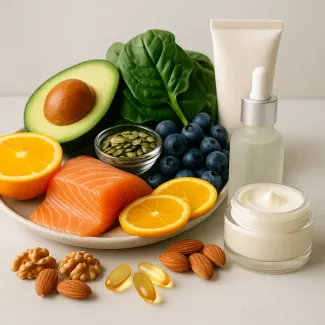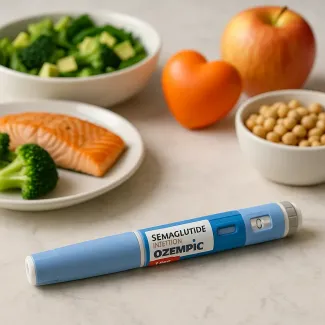
Sustainable strategies to support hormone balance after your 40s
How women can naturally reclaim energy, clarity, and hormonal harmony
As women transition through their 40s, subtle but profound hormonal changes begin to influence nearly every aspect of life. From fatigue and low libido to mood swings, brain fog, and unexplained weight gain, these symptoms are not random—they are your body’s way of signaling shifting hormonal landscapes. Unlike sudden changes that happen overnight, the shift in hormone levels—particularly estrogen, progesterone, cortisol, thyroid, and insulin—occurs gradually and subtly.
To navigate this period with confidence and vitality, it's essential to understand what’s happening inside your body and how small, intentional actions can restore balance. This guide focuses on natural, daily strategies to help you boost energy, maintain emotional equilibrium, and encourage hormonal resilience without relying on synthetic interventions.
The hormonal shifts that matter most after 40
As you enter your 40s, your ovarian function begins to slow down, leading to perimenopause, which can last several years before menopause sets in. One of the earliest hormones to decline is progesterone, followed by estrogen, and this imbalance can trigger symptoms like irritability, trouble sleeping, or irregular periods. At the same time, stress hormones such as cortisol may become elevated, and thyroid function can also begin to fluctuate.
Additionally, insulin resistance often increases in women over 40, which can lead to energy crashes, weight gain around the abdomen, and sugar cravings. These interrelated changes are not just inconvenient—they impact your metabolism, brain function, immune response, and emotional stability.
Prioritize consistent sleep to regulate hormone production
Sleep is a foundational pillar of hormonal health, especially as women age. Disruptions in your circadian rhythm can throw off your melatonin, cortisol, and growth hormone cycles, creating a ripple effect throughout your endocrine system.
To encourage deeper, uninterrupted rest:
- Maintain a consistent sleep schedule by going to bed and waking at the same time daily.
- Create a dark, cool, and quiet sleep environment, free of electronic devices.
- Avoid blue light exposure from screens 90 minutes before bedtime.
- Limit alcohol and caffeine, especially in the evening.
- Incorporate magnesium-rich foods such as almonds, spinach, and pumpkin seeds into your evening meals.
A rested body is better equipped to regulate stress, repair tissue, and maintain hormonal equilibrium.
Fuel your body with hormone-supportive nutrition
The foods you eat have a profound impact on your hormone production and metabolism. Nutrient-dense meals rich in fiber, healthy fats, complex carbohydrates, and quality proteins help maintain blood sugar balance, reduce inflammation, and support gut health, which in turn influences your estrogen detox pathways.
Focus on:
- Cruciferous vegetables (broccoli, kale, cauliflower) that help the liver process excess estrogen.
- Omega-3 fatty acids from wild salmon, flaxseeds, and walnuts to reduce inflammation.
- Lean protein like chicken, turkey, tofu, and legumes to stabilize blood sugar.
- High-fiber foods such as oats, chia seeds, and lentils to support regular bowel movements.
- Antioxidants from berries, leafy greens, and colorful vegetables to neutralize free radicals that impair hormone function.
Avoid refined sugars, processed foods, and excess caffeine, as they can spike insulin, deplete B vitamins, and interfere with adrenal health.
Movement that balances energy and hormones
Exercise is a powerful modulator of hormonal balance. It not only improves insulin sensitivity but also boosts dopamine and serotonin, which help regulate mood and sleep. However, not all workouts are equally beneficial at this stage of life. Overdoing high-intensity training can raise cortisol levels, leading to increased belly fat, muscle breakdown, and fatigue.
Ideal forms of movement for women over 40 include:
- Strength training two to three times per week to build lean muscle mass and enhance metabolic function.
- Walking daily to promote circulation, reduce cortisol, and support bone density.
- Yoga or Tai Chi to encourage parasympathetic nervous system activity and hormonal stability.
- Low-impact cardio such as swimming or cycling for cardiovascular health without excessive strain.
Incorporate recovery days and listen to your body’s energy cues to avoid overtraining.
Managing stress to stabilize cortisol and protect energy
Your adrenal glands are responsible for producing cortisol, the primary stress hormone. Chronic emotional or physiological stress can lead to adrenal dysregulation, contributing to fatigue, weight gain, and even disrupted estrogen production.
Build stress resilience with:
- Mindful breathing techniques (such as 4-7-8 breathing) to calm your nervous system.
- Meditation or guided visualization for 10–15 minutes daily.
- Spending time in nature to reduce mental clutter and promote emotional balance.
- Engaging in creative outlets like art, music, or journaling to express repressed emotions.
- Building strong social connections to support oxytocin release and emotional regulation.
Consistently managing stress enhances your body’s ability to maintain stable hormone levels.
Supporting gut health to influence estrogen detox and immune balance
The gut microbiome has a direct link to hormone regulation, particularly via the estrobolome—a collection of gut bacteria involved in metabolizing estrogen. If this system is imbalanced, excess estrogen can recirculate, leading to symptoms like PMS, heavy periods, or mood swings.
To improve your digestive health:
- Consume a variety of fermented foods like kimchi, sauerkraut, kefir, and yogurt for beneficial bacteria.
- Include prebiotic fibers such as garlic, onions, leeks, and asparagus to feed healthy microbes.
- Drink adequate water throughout the day to support bowel regularity.
- Limit antibiotics and NSAIDs that disrupt gut flora unless medically necessary.
A thriving gut promotes not only better digestion but also improves your body’s ability to detoxify hormones, regulate immune responses, and even impact your mood.
Balancing blood sugar to prevent energy crashes and hormonal spikes
Insulin resistance becomes more common after 40, especially with the decline in estrogen. This can result in energy dips, brain fog, and cravings for sugar and caffeine. Stable blood sugar is essential for maintaining a steady supply of cellular energy and reducing inflammation.
To keep your glucose levels stable:
- Eat protein and fat with every meal to slow carbohydrate absorption.
- Avoid skipping meals, which can spike cortisol and destabilize insulin.
- Incorporate chromium-rich foods like eggs, apples, and whole grains to support glucose control.
- Reduce consumption of simple carbs and sugary snacks that cause a blood sugar rollercoaster.
A stable blood sugar environment sets the stage for consistent hormonal output and improved daily vitality.
Nourishing your thyroid for metabolic and hormonal synergy
Your thyroid gland produces hormones that influence energy, metabolism, temperature regulation, and cognitive function. As women age, thyroid issues like hypothyroidism become more prevalent, often undiagnosed and misattributed to “just aging.”
To support thyroid health:
- Ensure adequate iodine intake from seaweed, eggs, and iodized salt.
- Get enough selenium from Brazil nuts, sunflower seeds, and tuna to convert T4 to active T3.
- Include zinc-rich foods like pumpkin seeds, shellfish, and legumes to support enzyme activity.
- Avoid excessive soy and gluten if sensitivity is suspected, as they may impair absorption.
A nourished thyroid helps regulate your entire hormonal ecosystem and fuels day-to-day mental clarity and stamina.
Choosing herbs and adaptogens to modulate hormonal stress
Adaptogens are plant compounds that help the body adapt to physical, emotional, or environmental stress. They act on the hypothalamic-pituitary-adrenal (HPA) axis, which is central to hormone communication and regulation.
Some effective adaptogens include:
- Ashwagandha: lowers cortisol and improves resilience to stress.
- Rhodiola rosea: enhances mental performance and combats fatigue.
- Maca root: supports estrogen balance and may enhance libido.
- Holy basil (tulsi): calms the nervous system and reduces inflammation.
Use under guidance, particularly if you have thyroid or hormonal conditions. Adaptogens work best when combined with lifestyle practices.
Reassessing your skincare and personal care products
Many conventional skincare, cosmetics, and cleaning products contain endocrine disruptors, such as parabens, phthalates, and BPA, which mimic estrogen and interfere with natural hormone signaling. These compounds can accumulate in the body over time, especially as detox capacity slows with age.
To minimize exposure:
- Switch to fragrance-free and natural personal care items.
- Use glass or stainless-steel containers instead of plastic.
- Look for certified organic or EWG-rated safe products.
- Avoid heating food in plastic containers, which can leach chemicals.
Reducing your toxic load supports healthier estrogen metabolism and minimizes risk of hormonal imbalance.
Cultivating emotional awareness to support hormonal rhythm
Your emotions are deeply tied to your hormonal state. Fluctuations in estrogen and progesterone can impact neurotransmitters like serotonin, dopamine, and GABA, influencing how you feel, think, and interact with others. Women over 40 often experience shifts in mood or motivation that are tied to deeper physiological processes.
To support emotional harmony:
- Practice self-compassion and reduce harsh inner dialogue.
- Journal your thoughts daily to process emotions and gain clarity.
- Engage in therapy or coaching if recurring patterns emerge.
- Learn to say no without guilt and protect your boundaries.
By nurturing your emotional landscape, you reinforce a stable internal rhythm that encourages smoother hormonal function.
Syncing with your menstrual and perimenopausal phases
Even if periods are becoming irregular, the body still follows cycles that affect energy, focus, motivation, and appetite. Learning to track your symptoms and adapt your lifestyle accordingly helps you stay in tune with your biological rhythms.
Try these practices:
- In your follicular phase (after your period), schedule new projects and workouts.
- During ovulation, focus on social and creative activities.
- In the luteal phase, prioritize rest, reflection, and nutrient-rich foods.
- During your menstrual phase, allow space for recovery and low-impact movement.
Living cyclically allows you to work with your hormones, not against them, even as perimenopause progresses.
Designing your day for hormone-friendly living
Ultimately, hormone balance is not achieved through one isolated habit, but through consistent, intentional choices woven into your everyday life. By building supportive routines in your mornings, evenings, and mealtimes, you reduce stress on your hormonal system and increase your body’s capacity for healing and regulation.
Start with:
- A gentle morning routine with hydration, sunlight, and light stretching.
- Midday movement breaks to keep blood sugar and energy stable.
- Evening wind-down rituals like herbal teas, stretching, and screen-free time.
- Daily gratitude practice to shift focus to positive emotional states.
When these habits are stacked over weeks and months, they create a resilient foundation that helps your hormones thrive—well into your 40s, 50s, and beyond.





